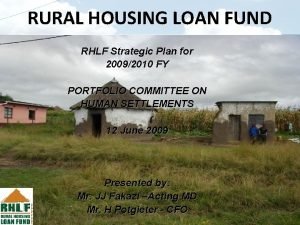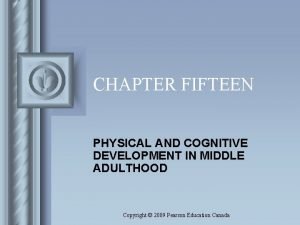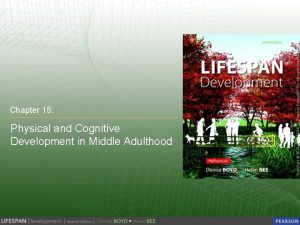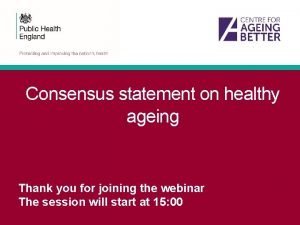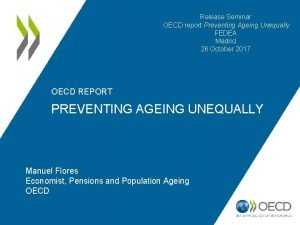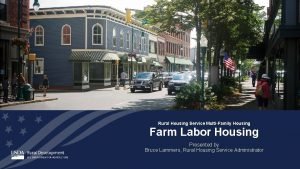Rural Housing our Ageing Population Preserving Independence 24















- Slides: 15

Rural Housing our Ageing Population: Preserving Independence 24 July 2018 Jeremy Porteus Managing Director @Housing. LIN

APPG Rural Housing for Older People Inquiry Terms of reference The aim of the inquiry is to consider the obstacles to ensuring older people living in rural areas enjoy appropriate housing and have access to adequate care and support at home; and to make recommendations to Government, and those planning, commissioning and operating housing and care in rural areas.

APPG HAPPI 4 - Methodology • Inquiry members made up of Parliamentarians and experts including CLA, ADASS and TCPA • APPG inquiry visits to North Yorkshire, Cheshire and Wales • 3 Inquiry sessions in Westminster with expert witnesses and the lived experience of older people • Call for evidence issued by the Housing LIN • Received written submissions

West Midlands representations • • Connexus Rooftop Housing Group Shropshire Housing Wychavon DC

HAPPI 4 – key messages “Our underlying concern is with the growing numbers of older people in rural communities who will face a huge challenge to their independence and wellbeing if their homes are no longer suitable. Their needs can be met by both small village developments – perhaps six bungalows on an unused scrap of land – or by larger scale retirement schemes in towns close by. While we concluded that both these solutions can work well, we were particularly keen to remove the barriers to helping people remain in their own locality. We recognised that there are extra costs of delivering care to those in rural areas, we were clear that tailor-made homes will, of themselves, reduce the need for care at home and help older people stay well for longer. ”

HAPPI 4 – what we found “We need to be more creative if we are to meet the housing needs of rural communities” Dominic Raab, Housing Minister “When a social problem [rural housing] reaches 'The Archers' you know it’s big” Richard Macer, BBC’s Battle in the Countryside “I want to grow older where I am. Living in a village is lovely. There is togetherness which I wouldn’t find so easily in a town whereas in a village I am not lonely at all. It’s idyllic, it’s peaceful, and it’s wonderful” Mrs June Rowberry, retired Rooftop Housing Group resident

Key rural infographics (1)

Key rural infographics (2)

Key rural infographics (3)

Should I stay or should I go? • • • Almshouses Community-led housing Extra care ‘hubs’/ retirement villages General Needs/bungalows Mainstream HAPPI housing Care and Repair/HIAs and handyperson services

HAPPI 4 – key areas covered • Meeting older people’s housing needs and aspirations – Healthier homes, rural baby-boomers, sheltered housing, wider housing choices, intergenerational housing, rural housing enabling, agri-business • Planning for later life housing in rural areas – NPPF, planning considerations, rural exception sites, better strategic planning, unlocking local authority land, s 106 etc • Prescribing better rural health and social care – Health & wellbeing, ageing population, hub and spoke models, social prescribing, broadband technology, voluteering and mutual support

HAPPI 4 – key recommendations • For Government – rural-proofing housing to stimulate growth, retain Local Plans in planning policy, adoption of Lifetime Homes and agefriendly HAPPI design, withhold Right to Buy, conversion of farm buildings ie for retirement purposes • For Homes England – use grant to support a viable market in rural areas, support Rural Housing Enablers and community-led approaches • For local authorities – strategic leadership, encourage housing for older people on rural exception sites, delivery HAPPI housing to offset expensie homecare & residential care in rural areas, support HIAs • For Housing organisations – more effective partnerships with CLTs, explore innovative technology to reduce isolation, create ‘hubs’, offer more housing choice, including almshouses • For landowners – work with LAs and HAs to develop suitable and affordable housing, inc for retired farmer workers, key workers etc

A rural housing pledge • Work closely with the local community and Parish Council to find the right site • Always give qualifying local people in housing need first priority for every home • Ensure that affordable homes always remain affordable • Build sensitively designed, high quality homes to high environmental standards • Provide good quality and locally sensitive management services to our residents, and • Always respond positively to the local community

Rural proofing HAPPI design principles The ten HAPPI design principles Rural proofed HAPPI features i Generous internal space standards ii Plenty of natural light in the home and circulation spaces iii Balconies and outdoor space, avoiding internal corridors and singleaspect flats iv Adaptability and ‘care aware’ design which is ready for emerging telecare and telehealthcare technologies v Circulation spaces that encourage interaction and avoid an ‘institutional feel’ vi Shared facilities and community ‘hubs’ where these are lacking in the neighbourhood vii Plants, trees, and the natural environment viii High levels of energy efficiency, with good ventilation to avoid overheating ix Extra storage for belongings and bicycles x Shared external areas such as ‘home zones’ that give priority to pedestrians i Generous internal space standards not least to allow for overnight visitors / carers ii Plenty of natural light with varied views and vistas iii Accessible private balconies or private outdoor space at ground floor iv Adaptability and ‘care aware’ design which is digitally / technology enabled v Circulation and break out spaces that encourage interaction and avoid ‘institutional feel’ vi Access to outward facing on-site shared facilities or community ‘hubs' within easy reach vii Easy access to green space, village green, natural landscape with resting and sitting places viii Fabric first approach, draught-free affordable warmth, ease of control and energy efficient ix Extra storage for personal belongings and ease of access to mobility aids x Close proximity of accessible public transport and level access for private transport drop off areas

Thank you! C/o EAC 3 rd Floor, 89 Albert Embankment London SE 1 7 TP email: dementia@housinglin. org. uk tel: 020 7820 8077 website: www. housinglin. org. uk Twitter: @Housing. LIN
 Japanese ageing population
Japanese ageing population Rhlf
Rhlf Section 502 guaranteed rural housing loan program
Section 502 guaranteed rural housing loan program Rural multifamily housing
Rural multifamily housing Denny's model of physical and cognitive ageing
Denny's model of physical and cognitive ageing Greater manchester ageing hub
Greater manchester ageing hub Subculture theory of aging
Subculture theory of aging Denny's model of physical and cognitive ageing
Denny's model of physical and cognitive ageing Ageing suit
Ageing suit Ageing to sageing
Ageing to sageing Greek theatre makeup
Greek theatre makeup Healthy ageing
Healthy ageing Preventing ageing unequally
Preventing ageing unequally National population and housing census 2011
National population and housing census 2011 Preserving your credit
Preserving your credit Ecology preserving the animal kingdom
Ecology preserving the animal kingdom

